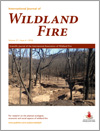International Journal of Wildland Fire
Volume 27
Number 6 2018
Large (>40 ha) human-caused and lightning-caused wildfires occurred on days with above-normal temperature, vapour pressure deficit, and below-normal fuel moisture than small fires across the USA. Higher winds were found over the first 2 days of fire discovery for large human-caused fires than for small human-caused fires and lightning-caused fires. These results suggest the importance of winds in initial attack success rates and in modelling large-fire risk in human-dominated landscapes.
Random and transect field sampling methods used for assessing burn severity are compared at 10 sites across Victoria, Australia. Transect sampling requires a sampling rate of 3.16% compared with 0.59% for random sampling. Also, sites smaller than 400 ha require a sampling rate 1.4–2.8 times that of sites larger than 400 ha.
Microscopic reflectance of charcoal produced in wildland fires records a semiquantitative proxy for fire severity. A comparison of charcoal produced by crown fires and surface fires in dry forests of the south-west USA indicates that these different fire types can be distinguished using the reflectance of the post-fire charcoal assemblage.
A suite of commonly applied burn severity spectral indices was evaluated against independently derived changes in forest canopy cover. Each spectral index was also evaluated for its ability to distinguish between severity classes. Overall, the Mid-Infrared Bi-spectral Index (MIRBI) outperformed the Normalised Burn Ratio (NBR) variants.
High resolution weather radar and remote sensing data are used to estimate and monitor soil erosion after storm events at near real-time in a burnt national park. This study provides timely information for monitoring the extent, magnitude and impact of soil erosion to assist park management.
After wildfire, a large proportion of the rodents that recolonise Mediterranean burnt areas come from the surrounding unburnt areas, which seem to be more important than internal refuges in the recolonisation process. When resources (food and refuges) are less limited and competition is still low, dispersing individuals from the unburnt area take advantage of sparsely occupied habitats and use internal refuges.




